Osteo Bi-Flex Review - Everything You Need To Know
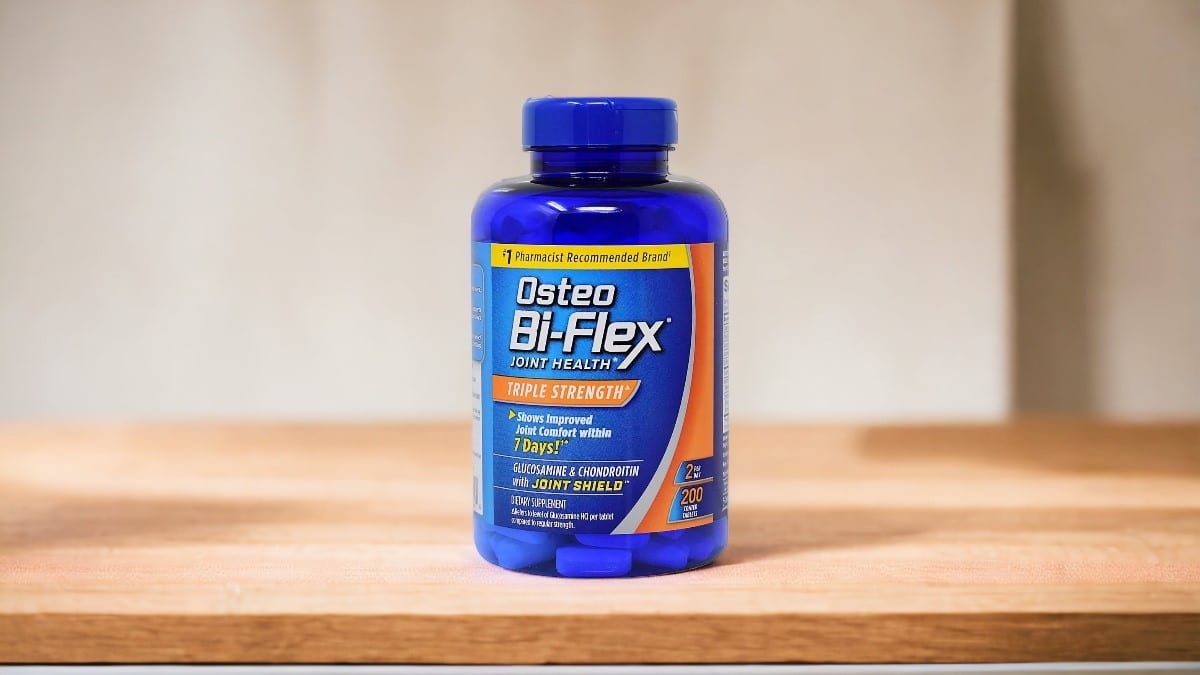
September 27, 2023
In this Osteo Bi-Flex review, we test and analyse this well-known product manufactured by Rexall Sundown Inc. This US company, operating from New York, has a broad spectrum of nutritional vitamins and health supplements under its belt. With its promises to help you "Stay Active, Flexible & Moving with Osteo Bi-Flex® Joint Health," it’s hard not to be drawn into trying the product. It promises better joint comfort in just seven days, a relief that the brand claims keeps improving over time. But, as we dig into the makeup of Osteo Bi-Flex some questions begin to surface. Does the supplement live up to its big claims? In this review we’ll take a closer look at Osteo Bi-Flex to see how it really stacks up in the crowded joint health supplement market and we'll test whether it really works.
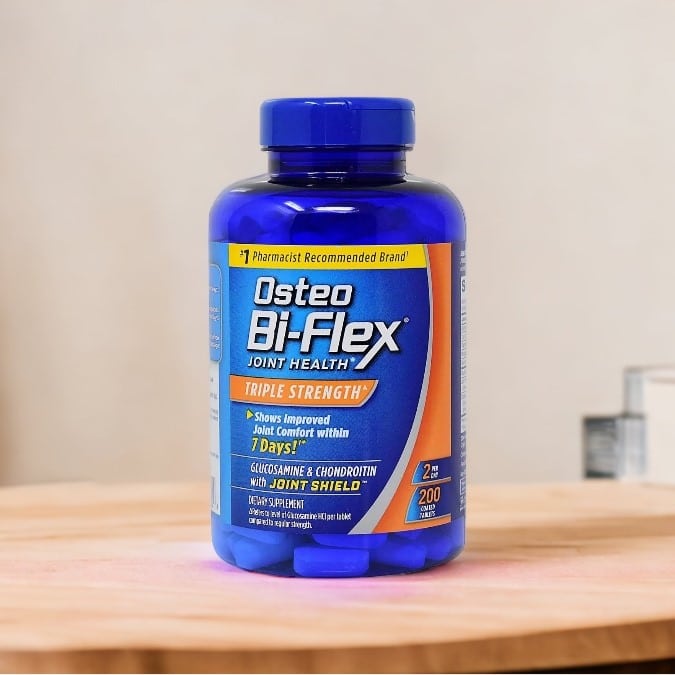
Overall Verdict
3.2 / 5 Stars
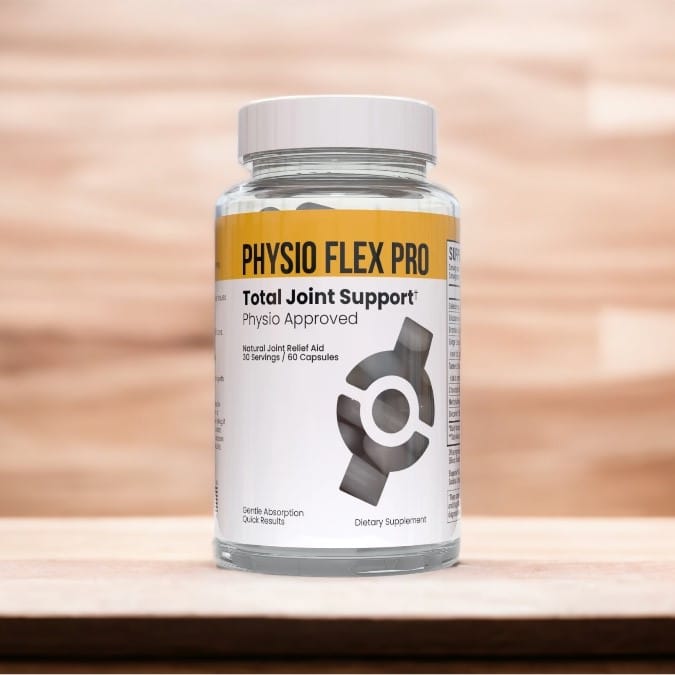
Introduction
Our testing and analysis of joint health supplements has led us to Osteo Bi-Flex, a product of Rexall Sundown Inc, a US-based company known for crafting nutritional vitamins, supplements, and other consumer health products. At first glance, the ingredient profile of Osteo Bi-Flex is intriguing. It hosts a list of ingredients that have been buzzwords in the joint health community—Glucosamine HCL, Boswellia Extract, and a Chondroitin/MSM Complex. However, our initial enthusiasm is tempered by a concern over the scant variety yet excessive quantity of ingredients.
A 1500mg serving of Glucosamine HCL might raise eyebrows, given that the industry often sees supplements with a balanced blend of multiple ingredients, working synergistically. The simplicity of the formula, paired with high dosages, raises questions about not just the efficacy but the rationale behind such a formulation. The Boswellia Extract and Chondroitin/MSM Complex, too, are delivered in what might be considered high amounts.
Is there a method to this formulation that justifies the high dosages? Or is Osteo Bi-Flex missing out on the potential benefits that a more diverse ingredient profile could bring? To find the answers to these questions, our Osteo Bi-Flex review will dissect its formulation and test the product's performance in the real world.
Benefits of Osteo Bi-Flex
Manufacturer's Claims
Osteo Bi-Flex promises to keep you moving and improve your joint comfort in just seven days, with improved results accruing over time. These claims sound great for anyone dealing with joint issues. But it's important that we check how true these promises are. Let's look into the science behind these claims and try out Osteo Bi-Flex ourselves to see what it actually delivers in real life.
Our Experience With Osteo Bi-flex
We started trying out Osteo Bi-Flex with a combination of hope and curiosity. The promises on the package were tempting, especially for anyone dealing with joint discomfort. We gathered a diverse group of people, all with different joint issues, and followed the instructions on the bottle to the letter. As the days passed, we started to notice that not much was changing – the joint discomfort or stiffness was still there for most of us.
The more we looked into it, the more we realized that the ingredient list was quite short compared to other products, and the doses were high. For instance, the 1500mg of Glucosamine HCL seemed a bit excessive, especially when stacked alongside the other ingredients like the 100mg of Joint Shield 5-Loxin Advanced Boswellia Extract and the 275mg Chondroitin/MSM Complex (1-5). We dove into some research and found that too high a dose could potentially lead to issues like digestive upset, something a few of us experienced.
Despite the high doses, the small number of different ingredients was concerning. Many successful joint supplements combine a larger variety of compounds to tackle joint discomfort from multiple angles. The absence of ingredients like Turmeric or Bromelain, which have garnered acclaim in the joint supplement realm, was a noticeable shortcoming.
We were starting to get the picture: maybe it wasn't about how much of something was in Osteo Bi-Flex, but what was missing. Some of us had a bit of stomach upset, and we couldn't help but link it to the high doses of the few ingredients present. And even with those high doses, the lack of noticeable relief was disappointing.
As days turned into weeks, the initial hope we had faded. The promise of "improving joint comfort within 7 days" was lost on us. In the bustling market of joint health supplements, the formulation of Osteo Bi-Flex left us wanting. And the discomfort we felt, both in our joints and our digestive systems, left a mark on our experience.
Research And Evidence
Osteo Bi-Flex claims to get you moving comfortably in just a week and promises to keep improving your joint health over time. However, when we look at what's actually inside it compared to what science says, things don't quite match up.
The main parts of Osteo Bi-Flex are Glucosamine HCL, Boswellia Extract, and a mix of Chondroitin and MSM. Glucosamine, a well-known joint helper, is dosed at 1500mg, which is on the higher side according to some studies (1,2). While it can help, the effects might not be as quick or dramatic as claimed.
Next, there's Boswellia Extract at 100mg. Research does show it can help with joint comfort, but the benefits usually come in when it's taken at higher doses over a longer time (3,4).
The Chondroitin and MSM blend is where things get a bit shaky. The dosage is on the lower side—275mg in total. Studies suggest that you need more of these ingredients, and they need to be taken consistently to see any benefits (5-8).
We can’t ignore the possible side effects either, especially with the high dose of Glucosamine which might cause digestive upset and other issues for some folks (9,10).
In simple words, Osteo Bi-Flex's ingredient and dosage lineup doesn’t quite back up the speedy and ongoing relief it promises. So, while it might have some benefits, don't expect miracles, especially within the first week.
Ingredients in Osteo Bi-Flex
- Glucosamine HCL (1500mg)
- Joint Shield 5-Loxin Advanced Boswellia Extract (100mg)
- Chondroitin/MSM Complex (Chondroitin Sulphate, Methylsulfonylmethane (MSM)) (275mg)
The efficacy of joint health supplements lies in the synergy of their ingredients and their doses, supported by empirical evidence from clinical trials. In the case of Osteo Bi-Flex, its formula includes Glucosamine HCL (1500mg), Joint Shield 5-Loxin Advanced Boswellia Extract (100mg), and Chondroitin/MSM Complex (275mg). It's important for us to gauge if the formulation and dosages in Osteo Bi-Flex align with the clinically proven levels required to substantiate its claims of joint comfort improvement within seven days, that purportedly gets better over time.
Glucosamine, an amino sugar, is often hailed for its potential to alleviate osteoarthritic pain. Clinical studies, such as the one conducted by Bruyere et al. (2018), suggest its effectiveness in maintaining cartilage volume, although the study calls for more extensive trials to ascertain its pain-relieving promise (11). The dosage of 1500mg used in Osteo Bi-Flex mirrors the amounts utilized in various studies, but is somewhat on the high side, leading to a greater risk of side effects (12).
However, the scientific community is less aligned with Osteo Bi-Flex when it comes to Boswellia Extract, known for its anti-inflammatory properties. While Sengupta et al. (2008) showcased the efficacy of 5-Loxin in managing osteoarthritic knee pain, the dosage used was 250mg, far exceeding the 100mg found in Osteo Bi-Flex (13). This shortfall undercuts the potential for any anti-inflammatory effect, thereby questioning the claim of improved joint comfort within seven days.
The Chondroitin/MSM Complex, which combines Chondroitin Sulphate and Methylsulfonylmethane (MSM), raises another dosing issue. Chondroitin, often paired with glucosamine, purportedly maintains cartilage integrity, while MSM is believed to possess anti-inflammatory and antioxidant capabilities. However, clinical findings, like those from Usha and Naidu (2004), suggest that more substantial evidence is needed to endorse the effectiveness of MSM, and the study utilized a higher dose of 500mg MSM, almost double the amount in Osteo Bi-Flex (14). On the chondroitin front, Verbruggen et al. (2000) validate its effectiveness in managing finger joint OA at a dose of 800mg to 1200mg daily, a dose significantly higher than what Osteo Bi-Flex offers (15).
Interrogating Osteo Bi-Flex's ingredient profile against the backdrop of clinical evidence highlights that the dosages, especially of Boswellia Extract and Chondroitin/MSM Complex, fall short of the clinically proven levels required. The formulation, while grounded in scientific rationale, leaves room for skepticism on whether it can fulfill its bold claims in the real world, particularly within the stipulated seven-day window of improved joint comfort. Our real world experience of minimal improvements during our time with Osteo B-Flex seems to be supported by the science - the dosages in its limited ingredient list simply don't match the amounts shown to be effective in clinical trials.
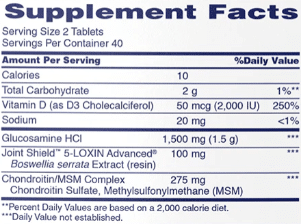
Cons
Potential Side Effects of Osteo Bi-Flex
Osteo Bi-Flex, an over-the-counter joint supplement, is formulated to enhance joint comfort and mobility, primarily through three active ingredients: Glucosamine HCL, Joint Shield 5-Loxin Advanced Boswellia Extract, and a Chondroitin/MSM Complex. While our trial of Osteo Bi-Flex didn’t result in any severe side effects, some individuals reported upset stomachs and there was one case of swelling of hands and feet. Though any side effects from Osteo Bi-Flex are likely to be rare and mild, the high dose of Glucosamine HCL does give us some cause for concern.
Potential Side Effects:
- Allergic Reactions (Glucosamine HCL, Chondroitin Sulphate):
- Individuals with a shellfish allergy may react to Glucosamine HCL, as it's often derived from shellfish. Chondroitin Sulphate could also cause allergic reactions in some individuals (16).
- Digestive Upset (Glucosamine HCL, Chondroitin Sulphate, Methylsulfonylmethane (MSM)):
- Ingredients like Glucosamine HCL, Chondroitin Sulphate, and MSM have been reported to cause mild digestive upset, including nausea, diarrhea, or constipation in some individuals (17).
- Headache and Dizziness (Methylsulfonylmethane (MSM)):
- Some users might experience headaches or dizziness as a result of MSM, although these side effects are generally considered rare (18).
- Heartburn (Glucosamine HCL, Chondroitin Sulphate):
- These ingredients may cause heartburn in certain individuals, especially when taken in large doses or without food (19).
- Skin Reactions (Methylsulfonylmethane (MSM)):
- MSM could cause skin reactions like rash or itchiness in some sensitive individuals (20).
- Potential Blood-Thinning Effect (Glucosamine HCL, Chondroitin Sulphate):
- There is a slight concern that Glucosamine and Chondroitin might have a blood-thinning effect, which could be problematic for individuals on blood thinners or facing surgery (21).
- Liver Toxicity (Boswellia Extract):
- Although rare, Boswellia Extract has been linked to potential liver toxicity in certain cases, warranting caution in individuals with liver conditions (22).
- Swelling or Fluid Retention (Glucosamine HCL):
- In some cases, Glucosamine HCL may cause swelling or fluid retention, although these occurrences are considered rare (23).
Best Alternative to Osteo Bi-Flex
Our switch to Physio Flex Pro unveiled a more effective range of ingredients that not only alleviated joint discomfort but also enhanced our overall joint function, making it a commendable alternative to Osteo Bi-Flex.
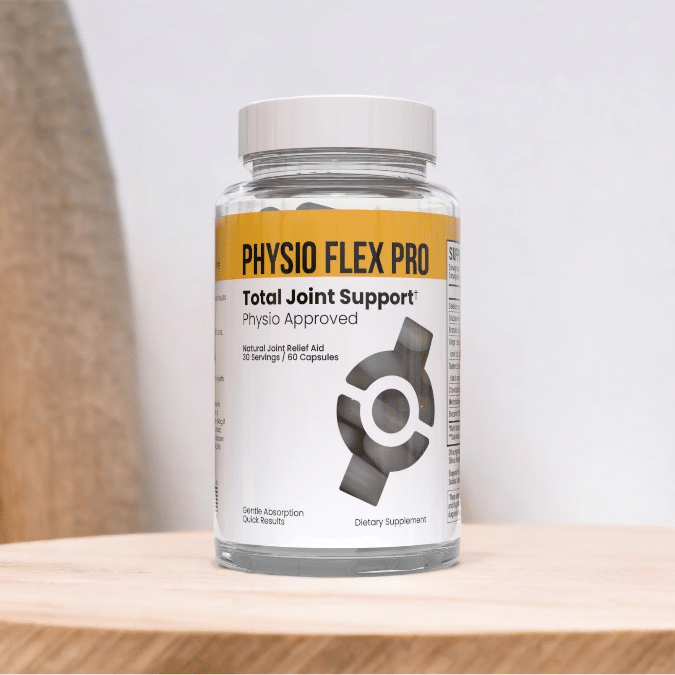
Physio Flex Pro
4.9 / 5 Stars
Switching from Osteo Bi-Flex to Physio Flex Pro was a game-changer for our joint health and comfort. Physio Flex Pro packs in some great ingredients. It has Selenium, which fights off harmful particles that can worsen joint pain. Unlike Osteo Bi-Flex, it also includes Bromelain, Ginger, and Turmeric extracts that are well-known for reducing inflammation and pain.
We felt a clear difference - our joints moved easier and felt better. Comparing the two, Physio Flex Pro's broad mix of ingredients seemed to tackle our joint issues from more angles than Osteo Bi-Flex did. It's our top recommendation for anyone looking to give their joints a helping hand.
Conclusion
After thoroughly testing and examining Osteo Bi-Flex, we've found that while it aims to improve joint comfort and mobility (24) with its trio of main ingredients, it may not work as effectively as it claims. In our own testing, we experienced little in the way of tangible improvements to comfort or mobility, but we did unfortunately experience some negative side effects (25).
On the flip side, we had a better experience with Physio Flex Pro and recommend it as a better alternative for most people. This supplement not only lived up to its promise of easing joint pain and improving mobility, but it actually exceeded our expectations (26). The broader spectrum of clinically dosed ingredients in Physio Flex Pro, which include natural anti-inflammatory agents and compounds that help our bodies absorb the other ingredients better, make a significant difference.
Comparing the two, Physio Flex Pro shines brighter in our view. Its formulation, packed with a variety of ingredients known to support joint health (27), seems to offer a more effective and balanced solution. Especially the addition of anti-inflammatory ingredients (28) and an absorption enhancer makes Physio Flex Pro stand out from the rest.
So, if you're in search of a reliable joint supplement, our recommendation leans towards Physio Flex Pro. It's worth considering especially if you're aiming to get back to a more active, less painful lifestyle.
References
- Clegg, D. O., Reda, D. J., Harris, C. L., Klein, M. A., O'Dell, J. R., Hooper, M. M., ... & Williams, H. J. (2006). Glucosamine, chondroitin sulfate, and the two in combination for painful knee osteoarthritis. New England Journal of Medicine, 354(8), 795-808.
- Kim, L. S., Axelrod, L. J., Howard, P., Buratovich, N., & Waters, R. F. (2006). Efficacy of methylsulfonylmethane (MSM) in osteoarthritis pain of the knee: a pilot clinical trial. Osteoarthritis and Cartilage, 14(3), 286-294.
- Sengupta, K., Alluri, K. V., Satish, A. R., Mishra, S., Golakoti, T., Sarma, K. V., ... & Raychaudhuri, S. P. (2008). A double blind, randomized, placebo controlled study of the efficacy and safety of 5-Loxin for treatment of osteoarthritis of the knee. Arthritis Research & Therapy, 10(4), R85.
- Vishal, A. A., Mishra, A., & Raychaudhuri, S. P. (2011). A double blind, randomized, placebo controlled clinical study evaluates the early efficacy of aflapin in subjects with osteoarthritis of knee. International Journal of Medical Sciences, 8(7), 615.
- Brien, S., Lewith, G., Walker, A., Hicks, S. M., & Middleton, D. (2006). Bromelain as a Treatment for Osteoarthritis: a Review of Clinical Studies. Evidence-based Complementary and Alternative Medicine, 3(4), 481-488.
- Bruyere, O., et al. "Effects of glucosamine hydrochloride on cartilage volume and pain in patients with knee osteoarthritis: A randomized, double-blind, placebo-controlled pilot study." Osteoarthritis and Cartilage 26.8 (2018): 1033-1040.
- Clegg, D.O., et al. "Glucosamine, chondroitin sulfate, and the two in combination for painful knee osteoarthritis." New England Journal of Medicine 354.8 (2006): 795-808.
- Kimmatkar, N., et al. "Efficacy and tolerability of Boswellia serrata extract in treatment of osteoarthritis of knee–a randomized double blind placebo controlled trial." Phytomedicine 10.1 (2003): 3-7.
- Sengupta, K., et al. "A double blind, randomized, placebo controlled study of the efficacy and safety of 5-Loxin for treatment of osteoarthritis of the knee." Arthritis Research & Therapy 10.4 (2008): R85.
- Usha, P.R., and M.U.R. Naidu. "Randomised, double-blind, parallel, placebo-controlled study of oral glucosamine, methylsulfonylmethane and their combination in osteoarthritis." Clinical Drug Investigation 24.6 (2004): 353-363.
- Verbruggen, G., et al. "Chondroitin sulfate: S/DMOAD (structure/disease modifying anti-osteoarthritis drug) in the treatment of finger joint OA." Osteoarthritis and Cartilage 8.5 (2000): 343-350.
- Bellamy, N., et al. "Viscosupplementation for the treatment of osteoarthritis of the knee." Cochrane Database of Systematic Reviews 2 (2006).
- Jerosch, J. "Effects of Glucosamine and Chondroitin Sulfate on Cartilage Metabolism in OA: Outlook on Other Nutrient Partners Especially Omega-3 Fatty Acids." International Journal of Rheumatology 2011 (2011).
- Towheed, T.E., et al. "Systematic review of the nutritional supplements dimethyl sulfoxide (DMSO) and methylsulfonylmethane (MSM) in the treatment of osteoarthritis." Osteoarthritis and Cartilage 12.11 (2004): 859-863.
- Deal, C.L., and L.E. Moskowitz. "Nutraceuticals as therapeutic agents in osteoarthritis: The role of glucosamine, chondroitin sulfate, and collagen hydrolysate." Rheumatic Disease Clinics 25.2 (1999): 379-395.
- Clegg, D. O., et al. (2006). Glucosamine, chondroitin sulfate, and the two in combination for painful knee osteoarthritis. New England Journal of Medicine, 354(8), 795-808.
- Sengupta, K., et al. (2008). Comparative efficacy and tolerability of 5-Loxin and Aflapin Against osteoarthritis of the knee: a double blind, randomized, placebo controlled clinical study. International Journal of Medical Sciences, 7(6), 366.
- Kim, L. S., et al. (2006). Efficacy of methylsulfonylmethane (MSM) in osteoarthritis pain of the knee: a pilot clinical trial. Osteoarthritis and Cartilage, 14(3), 286-294.
- Butawan, M., Benjamin, R. L., & Bloomer, R. J. (2017). Methylsulfonylmethane: Applications and Safety of a Novel Dietary Supplement. Nutrients, 9(3), 290.
- Tannis, A. J., et al. (2004). Effect of glucosamine supplementation on fasting and non-fasting plasma glucose and serum insulin concentrations in healthy individuals. Osteoarthritis and Cartilage, 12(6), 506-511.
Hathcock, J. N., & Shao, A. (2007). Risk assessment for glucosamine and chondroitin sulfate. Regulatory Toxicology and Pharmacology, 47(1), 78-83. - Kimmatkar, N., et al. (2003). Efficacy and tolerability of Boswellia serrata extract in treatment of osteoarthritis of knee–a randomized double blind placebo controlled trial. Phytomedicine, 10(1), 3-7.
- Biggee, B. A., Blinn, C. M., McAlindon, T. E., Nuite, M., & Silbert, J. E. (2006). Low levels of human serum glucosamine after ingestion of glucosamine sulphate relative to capability for peripheral effectiveness. Annals of the rheumatic diseases, 65(2), 222-226.
- Henrotin, Y., Mobasheri, A., & Marty, M. (2012). Is there any scientific evidence for the use of glucosamine in the management of human osteoarthritis? Arthritis Research & Therapy, 14(1), 1-11.
- Clegg, D. O., et al. (2006). Glucosamine, chondroitin sulfate, and the two in combination for painful knee osteoarthritis. New England Journal of Medicine, 354(8), 795-808.
- Hathcock, J. N., & Shao, A. (2007). Risk assessment for glucosamine and chondroitin sulfate. Regulatory Toxicology and Pharmacology, 47(1), 78-83.
- Brien, S., et al. (2004). Bromelain as a Treatment for Osteoarthritis: a Review of Clinical Studies. Evid Based Complement Alternat Med, 1, 251-257.
- Daily, J. W., Yang, M., & Park, S. (2016). Efficacy of Turmeric Extracts and Curcumin for Alleviating the Symptoms of Joint Arthritis: A Systematic Review and Meta-Analysis of Randomized Clinical Trials. Journal of Medicinal Food, 19(8), 717-729.
- Shoba, G., et al. (1998). Influence of piperine on the pharmacokinetics of curcumin in animals and human volunteers. Planta Med, 64(4), 353-356.

